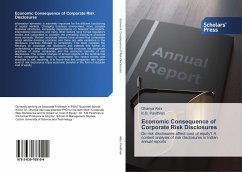Information symmetry is extremely important for the efficient functioning of capital markets. Changing business environment, more complex business structures, increasing dependence on financial instruments, international exposures and many other factors have forced regulatory bodies and corporates to consider the prevailing disclosure practices more seriously. Recent corporate failures have proved that companies adopt window dressing practices and there are wide variations in the disclosure practices followed by companies. This book complies the literature on corporate risk disclosure and extends this further by undertaking an empirical investigation into the corporate risk disclosure practices of Indian companies and the economic benefits of risk disclosures. The content analysis of annual reports of the nonfinancial Indian companies was done to understand the recent trends and practices in risk reporting. It is found that the companies with higher level of risk disclosures enjoy economic benefits in the form of reduced cost of equity.
Bitte wählen Sie Ihr Anliegen aus.
Rechnungen
Retourenschein anfordern
Bestellstatus
Storno








